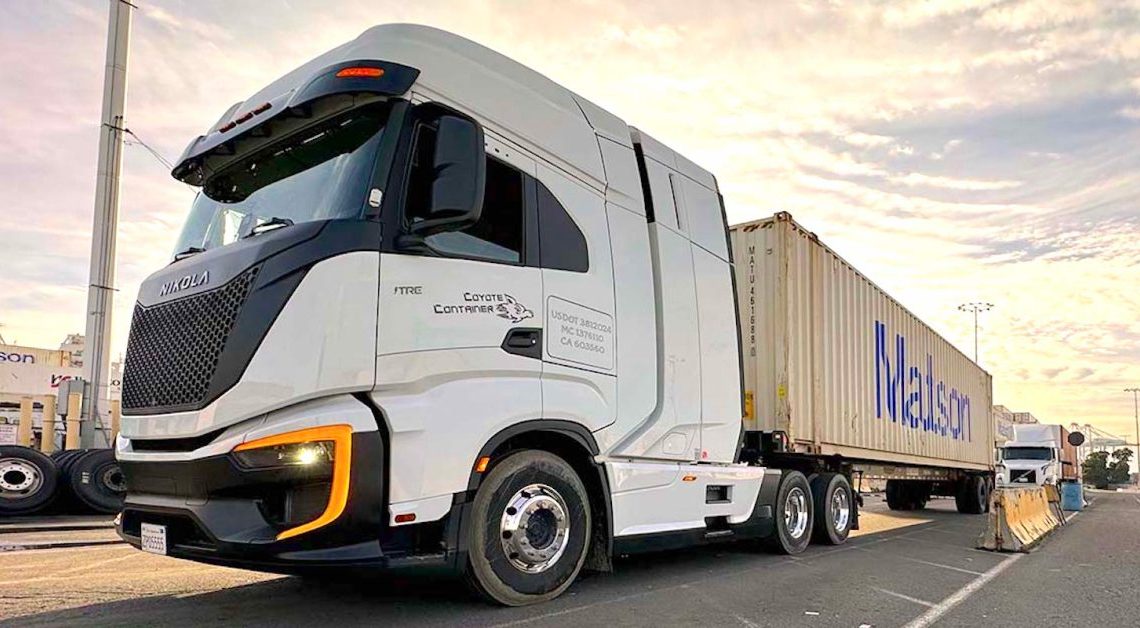
The port cartage and drayage specialists at Coyote Container successfully completed a 400-mile delivery in a Nikola Tre semi truck powered by a hydrogen fuel cell.
William Hall, Managing Member and Founder of Coyote Container, drove the hydrogen Nikola over the hilly, 400-mile route that took the truck and its 17.7 ton trailer through California’s Altamont Pass and Grapevine Canyon on the I-5 interstate between the Port of Oakland and the Port of Los Angeles in Long Beach. One part of the trip, Tejon Pass, features an elevation that’s some 4160 feet above sea level.
“The truck is a dream to drive and I arrived at Pier C with about 140 miles of remaining range,” explains Hall. “I drove conservatively and did the steep climbs at 40 mph, much as I would in a diesel with that load profile, though I could have easily gone 55 (mph).”
Coyote Container’s Nikola Tre HFCEV semi was one of 35 hydrogen-powered trucks delivered to customers by Nikola late last year, and is reported to be the first such truck to complete a trip like this in customers’ hands.
The truck was able to “top off” in SoCal for its trip home thanks to a late 2023 deal Nikola formalized with FirstElement Fuel (FEF), which gives Nikola customers to access hydrogen fueling services at the new FEF multi-use heavy-duty truck station situated near the port in Oakland, California.
Big step for Bosch, doubts about Nikola remain




Covering Nikola is always something I hesitate to do. On the one hand, I very much want the new, Trevor-free Nikola to succeed. On the other, the stink of his corruption and inappropriate cousin-touching still lingers slightly, despite the concerted and above-board efforts of everyone involved to move beyond the scandals and the cons.
Indeed, everyone I’ve spoken to at the company over the course of the past few years has seemed remarkably credible. And yet, the company is about to be delisted from the NASDAQ (again), while even the most ardent Nikola supporter would have to admit that, despite the fact that Nikola and Coyote Container seem to be taking the credit for this trip’s success, the real credit here should go to Bosch.
It was the team at Bosch, after all, who developed the fuel cell used in the Nikola Tre that made this trip. I took the photos, above, at last year’s ACT Expo and this year’s CES show specifically to point out just how much of Bosch’s fuel cell tech was derived from – if not lifted directly – its existing line of automotive components, from throttle bodies and actuators to turbocharger housings and electronic control units (ECUs).
All of which, while cool from a techno-nerd perspective, just underscores how badly the legacy automakers, and their suppliers, want and/or need hydrogen to become a thing. The problem, of course, is that it’s probably not going to become a thing.
Electrek’s Take
MAN CEO, Alexander Vlaskamp, said it best when he said that it was “impossible” for hydrogen to effectively compete with BEVs. He’s right – on a level playing field, there is absolutely no reason to believe hydrogen has any kind of future.
But we don’t operate on a level playing field. Governments all over the world have subsidized oil prices for decades to the tune of trillions of dollars, holding back the progress of more sustainable fuels and energy sources alike. If the economic powers behind the oil and gas companies are backing hydrogen now – either because they have the tools, know-how, and infrastructure to do so effectively, or just as a red herring to distract from and delay battery-electric’s ultimate victory while they squeeze every last cent they can out of fossil fuel extraction – it might be just a matter of time before new subsidies make hydrogen economically viable for transport.
If that happens Nikola’s future, and Bosch’s, might be bright.
Author: Jo Borrás
Source: Electrek





